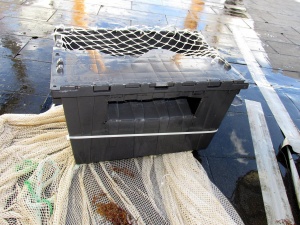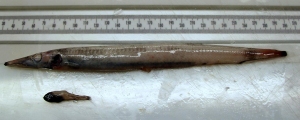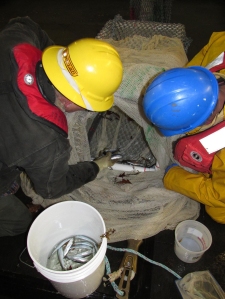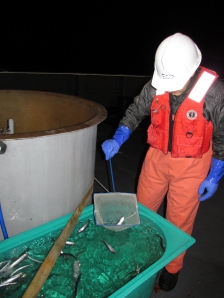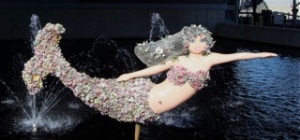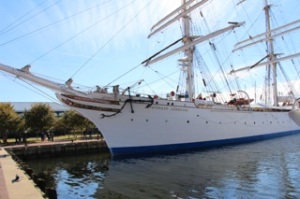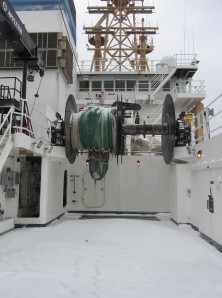The Pisces has made its final trawl and is now heading towards its last plankton station before it will dock in Little Creek, Norfolk, Virginia for the end of this cruise later today. Since our last update we’ve weathered persistent gale-force winds that caused us to miss our first and only station of this entire survey, when gusts of forty knot winds forced us to abort setting the Shallow-Water midwater trawl just before dawn on Monday morning. We altered course to continue working in a more sheltered area further south. Subsequent trawls made late last night have been small in quantity but highly diverse in composition, with cutlass fish, bluefish, a puffer fish, small squid, salps and even a seahorse! We are now heading for our last plankton station which we should arrive at in the wee hours of this Wednesday morning.
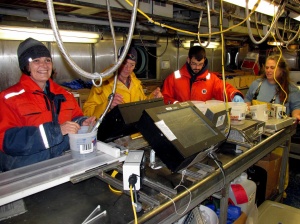
The night watch processing one of the last midwater trawl catches of the cruise. Photo by Jerry Prezioso, NEFSC/NOAA

Rich Bell holding a cutlass fish caught in the midwater trawl. Photo by Maura Thomas, University of Maine
This has been an interesting cruise owing to its multi-pronged approach for studying the waters of the northeast continental shelf. Using a variety of tools wielded by scientists from different disciplines, marine life from phyto- and zoo-plankton, to larval, juvenile and adult fish have been studied, together with a backdrop of oceanographic measurements of water temperatures and salinities, and light, chlorophyll, and nutrient levels. The onboard experiment to measure respiration of various fish was a first for one of these survey cruises.

Emily Brownlee and an Imaging Flow Cytobot Unit from WHOI. Photo by Jerry Prezioso, NEFSC/NOAA
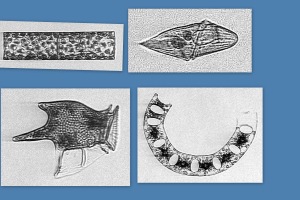
Diatoms and dinoflagellates photographed by the Imaging Flow Cytobot units. Photo by Emily Brownlee, WHOI
There has also been an educational component, where students from Prout High School and Davisville Middle School in Rhode Island, sent highly decorated styrofoam coffee cups and manikin heads out with us to be submerged along with our instruments to depths of 500 meters (1,640 feet) to demonstrate the effect of pressure on them.

Styrofoam cups in mesh bag mounted below instruments on CTD rosette. Photo by Jerry Prezioso, NEFSC/ NOAA

Styrofoam cups and manikin heads from Davis Middle School (top) and Prout High School (bottom) after 36 submersions on CTD rosette. Photo by Jerry Prezioso, NEFSC/ NOAA.
All of this was accomplished in an area ranging from as far north as the Bay of Fundy in the Gulf of Maine, to as far east as the Northeast Channel off of Georges Bank, down to Cape Hatteras, North Carolina in the south in just seventeen days. Truly a remarkable achievement, and we, the scientists on this survey, want to thank the officers and crew of the Pisces for doing their utmost to make this possible. By utilizing this vessel to its fullest capabilities, and with their constant help and advice, they have enabled us to accomplish a lot in a short time.

Crewmen Victor Coleman and Jeff Brawley from the Pisces deploying bongo plankton nets. Photo by Jerry Prezioso, NEFSC/NOAA
We thank you and wish you all a very Happy Thanksgiving!
Jerry Prezioso
Chief Scientist
PC1405 NE Pelagic-EcoMon Survey





